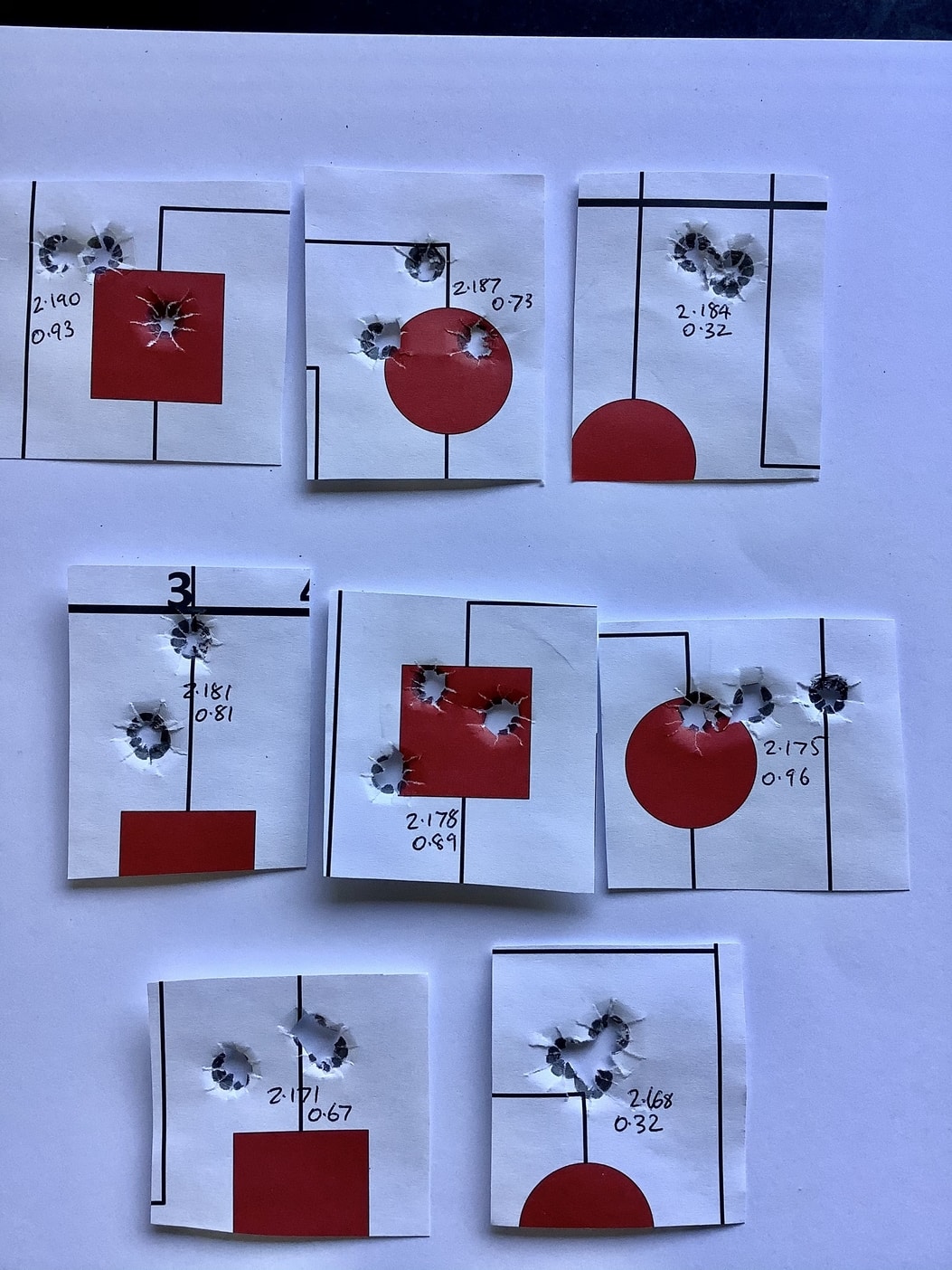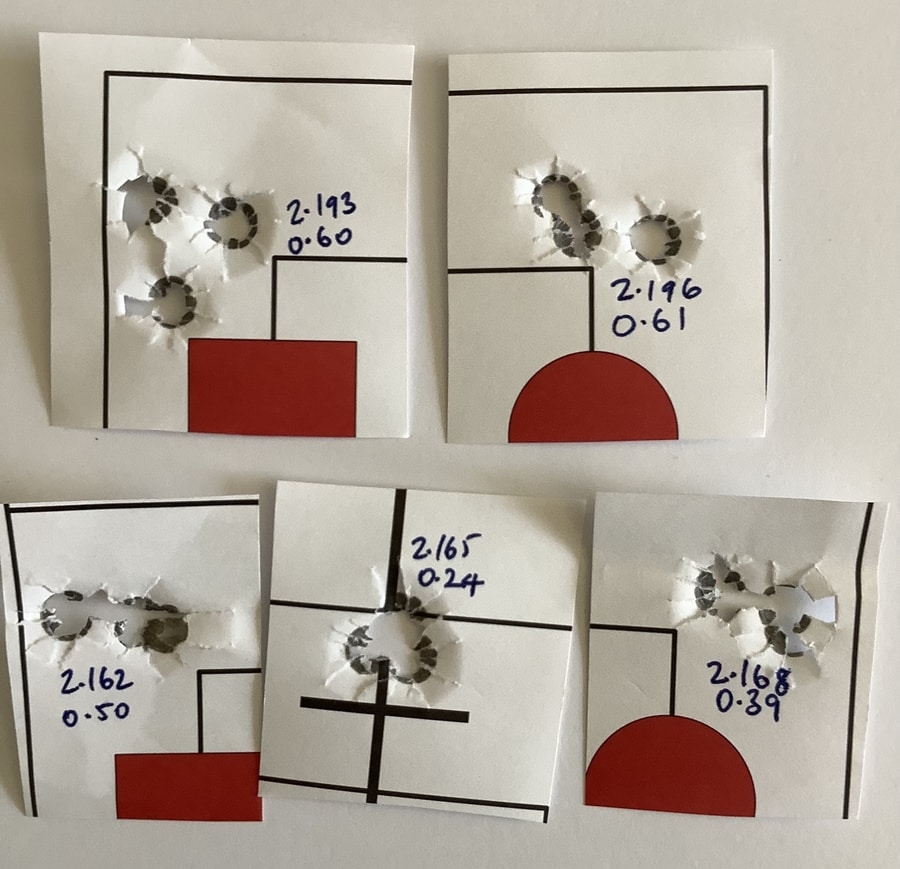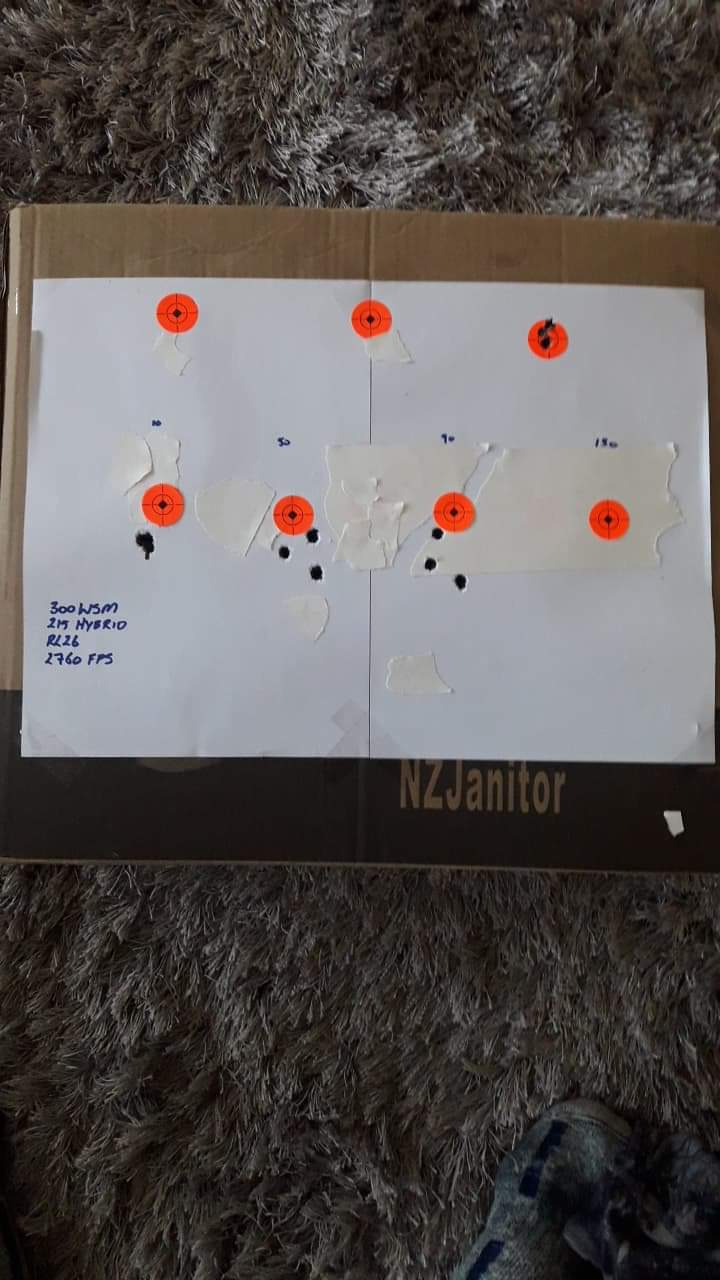I did the Berger version with my 300wsm
I didnt fire the -130 as it was pretty obvious where things were working. Top right was comformation of -10 load and zero
Welcome guest, is this your first visit? Create Account now to join.
Welcome to the NZ Hunting and Shooting Forums.
Search Forums
User Tag List
+ Reply to Thread
Results 121 to 135 of 205
-
24-12-2020, 11:41 AM #121
-
-
06-01-2021, 12:47 PM #122Member

- Join Date
- Sep 2019
- Location
- Christchurch
- Posts
- 89
After watching the Erik Cortina YouTube videos and following this thread, I thought I’d give it a go. Thanks DannyB for starting it up. I waste far too much time and too many components on load testing, so any ‘short cut’ that works is great. The test rifle is a Savage actioned ‘back-up’ 308 Winchester target rifle for F-TR and F-PR competition and practice.
Specs are:
Savage Model 16 stainless action with a Rifle Basix trigger, epoxy bedded in a Boyds laminate target-style stock. Barrel is 28” 1:10 twist stainless M24 profile (straight taper to 0.950” muzzle), made by Hugh Bradley. Chambered with a 308 Winchester tight-neck ‘Palma’ reamer by Les Grimsey. It has been showing some good accuracy potential. Scope is a Sightron SIII 8-32x56 in Leupold rings and I’ll be using an F-TR style bipod and rear bag.
I have some Sierra 155grn ‘Palma’ projectiles that haven’t been shot in this rifle before, to use for this test.
For the velocity test stage, my load specs are:
Lapua Small Rifle Primer 308Win brass (annealed with an AMP annealer), CCI 450 primers, Sierra 155 Palma projectiles, seated 20 thou off the lands (measured with a firm push into the lands with a Hornady seating depth gauge).
Load is 8208 powder, with four each of: 45.3, 45.5, 45.7, 45.9 and 46.1 grains (three for data, one extra in case the chronograph doesn’t register a shot). These loads are up to a grain over the maximum of the Sierra manual. It works for me, as the small rifle primer brass typically needs more powder to reach the same velocity/pressure as large rifle primer brass, and I’ve been shooting similar loads in this rifle with no pressure issues. It may not work for you, so it goes without saying to stay with reloading manual loads.
I’m a fan of small steps, as I think nodes can be quite small (and easy to miss with bigger steps).
Chronograph results (with a LabRadar chronograph):
45.3 – 3002, 3009, 2991 – ES = 18 – SD = 9.1
45.5 – 3005, 3006, 3006, 3011 – ES = 7 – SD = 3.0
45.7 – 3031, 3027, 3014 – ES = 17 – SD = 8.7
45.9 – 3050, 3033, 3042 – ES = 17 – SD = 8.4
46.1 – 3064, 3041, 3058 – ES =23 – SD = 9.7
45.5 looks like the clear winner. Given the ES of 2 after three shots, the fourth was fired and it is still very good. The bolt had very slight resistance to lifting for the 46.1 load, so I’m happy to be 0.6grn under that.
Forecast to rain tomorrow, so I’ll load up the length-test series, and hopefully test on Friday and report.
Any comments, questions or critique most welcome.
-
06-01-2021, 01:04 PM #123Banned

- Join Date
- Mar 2015
- Location
- North Canterbury
- Posts
- 5,462
Good result with 45.5. Was that what you expected ? I am surprised that the loads either side didnt have a lower ES, putting you in the middle of a sweet spot rather than in the middle of some ordinary ES loads.
I have had similar and dont understand it fully
-
06-01-2021, 11:03 PM #124Member

- Join Date
- Aug 2019
- Location
- Waikato
- Posts
- 216
All nice results and I would be happy with any of them if I can tie it to a consistent good group at 500m. Shows excellent, consistent reloading procedures from you.
I recon the middle of the node will be before 45.5gr. Why? Look at the different increases of velocity per 0.2gr of powder for each group vs the ones below and above...
-
10-01-2021, 10:43 AM #125Member

- Join Date
- Sep 2019
- Location
- Christchurch
- Posts
- 89
Soooo, some results...
"Inconclusive" would be the one-word summary. Maybe my expectations were a bit high, but I'll need to do a bit more testing. A couple of good groups, but not yet Cortina's 'wide-node' of two consecutive small groups. In the end I did 8 different seating depths, in 0.003" increments (one was a 0.004" increment). All were seated with a Forster press-mounted die (it seems to give me the lowest run-out) to 2.190", measured with a Hornady gauge thingy. Then I seated to depth with a Wilson micrometer hand-die at the range, and measured each one.

I'm thinking I'll now try two steps closer to the lands (2.193 and 2.196") and repeat 2.168" and do two more steps that way (2.165 and 2.162).
@JaSa - Yeah, I figure the velocity node is probably a bit below 45.5 given the trend. They are loaded with an RCBS Chargemaster, so +/-0.1grains is likely happening anyway.
@Moa Hunter - Yup, there is much I don't understand too. I think Litz is onto it when he says we read far too much into very small data-sets - statistically the the good groups above could be just random occurrences.
-
10-01-2021, 11:32 AM #126
Couple of cracking groups there...if either proved repeatable I'd be very happy.
-
10-01-2021, 11:48 AM #127Banned

- Join Date
- Mar 2015
- Location
- North Canterbury
- Posts
- 5,462
Certainly looks like 2168 is headed / trending into a wide node. Takes a lot of time this !
One thing I would like to do myself is fire one shot every morning from a cold barrel to give a five shot group at the end of the week. A chap on youtube explained he did that when he had his final hunting load
-
10-01-2021, 12:30 PM #128
Looks like might be worth a group at 2.165 to see if you are at longer end of that node with first group, if it gave .7 or less I'd be thinking 2.168 is in the middle and good to go (provided it is repeatable)
-
10-01-2021, 12:52 PM #129
Have done it in the past on a monthly basis and recently on a weekly basis when training or load development on other guns.
Once I worked out the wind at our local range. I managed a 5 month 1.3" group @200 yrds but didn't run it over the Chrony.
I am 4 rnds into a similar test over the radar and although the group isint quite as good (waterline) the ES so far is 6fps.
If I fire another round within say 10mins my velocity jumps 40fps and ES stays within 10-16 fps for consecutive shots.
I was interested in determining my fouled cold bore consistency as it is a hunting load.
Apart from the 40fps jump ( has me a tiny bit confused ) when shooting consecutive shots on the cold bore I am pretty happy as the rifle never gets stretched beyond 500 yrds on game and the cold bore shot velocity hasn't so far, changed from winter to summer and that is using RL26 which is claimed to be temp sensitive.
As for the above. I can see an obvious node between 2.168 and 2.175.
Sent from my SM-T510 using TapatalkDo what ya want! Ya will anyway.
-
10-01-2021, 12:57 PM #130
-
10-01-2021, 01:06 PM #131

The area circled (including the shorter length not yet tested) looks hopeful
-
10-01-2021, 02:51 PM #132Member

- Join Date
- Sep 2019
- Location
- Christchurch
- Posts
- 89
Thanks distant stalker for that extra analysis. I will let you know how I get on with the next test batch in a few days.
@R93 - the cold bore first shot velocity difference and clean bore vs fouled bore velocity difference is a common phenomenon. The long-range target stuff that I do is out to 900yds - you get two 'sighters', then (normally) 10 counting shots. The first shot of the day is pretty much always lower vertically, usually more so for a clean bore, due to that velocity difference.
-
10-01-2021, 03:02 PM #133
I am aware of the clean bore cold shot. This barrel normally takes 3 rnds from clean to settle and hit POA. Just a bit surprised I am getting a 40fps jump after a fouled barrel cold shot.
I am assuming it is the same principle but have had excellent ES in this rifle over a 5 shot string from cold without a jump in velocity. I am a bit confused as to why it has come up now. However the cold fouled shot over the last year or so has been extremely consistent so no need to worry too much about it for a hunting rifle.
Sent from my SM-T510 using TapatalkDo what ya want! Ya will anyway.
-
13-01-2021, 06:27 PM #134Member

- Join Date
- Sep 2019
- Location
- Christchurch
- Posts
- 89
This time the summary is two words: pleasantly surprised.
Given the first depth-seating test series indicated a narrow node within the range and strong hints of a node at the end (longest jump-to-the-lands tested), I loaded up 3 each of:
2.193 and 2.196 (closer to the lands approx. 0.017 and 0.014)
2.168 (repeating the good result at the end of the last test series)
2.165 and 2.162 (two steps further from the lands)
The results show:
(a) a pleasing repeatability of the 2.168 group
(b) a broad node from about 2.162 to 2.168.

Given the Cortina instructions, I should now pick 2.167 as my seating depth.
I put the chronograph back on for the last 9 and recorded an average velocity of 2995, with an ES of 19 and a SD of 5.5, so pretty happy with that.
Thanks to all for your suggestions, comments and likes. Cheers, M
-
13-01-2021, 06:41 PM #135
Similar Threads
-
Load development in the SI
By Strider B in forum Reloading and BallisticsReplies: 21Last Post: 02-09-2020, 09:31 AM -
6.5 Creedmoor load development
By Wingman in forum Reloading and BallisticsReplies: 118Last Post: 29-09-2019, 10:38 PM -
300 Wsm Load development
By mcche171 in forum Reloading and BallisticsReplies: 10Last Post: 23-05-2019, 03:22 PM -
A novel approach to Load Development
By Puffin in forum Reloading and BallisticsReplies: 2Last Post: 16-08-2018, 11:36 AM -
Load development
By Cartman in forum Reloading and BallisticsReplies: 8Last Post: 30-07-2015, 10:42 PM
Tags for this Thread
Welcome to NZ Hunting and Shooting Forums! We see you're new here, or arn't logged in. Create an account, and Login for full access including our FREE BUY and SELL section Register NOW!!





 304Likes
304Likes LinkBack URL
LinkBack URL About LinkBacks
About LinkBacks




 Reply With Quote
Reply With Quote



Bookmarks